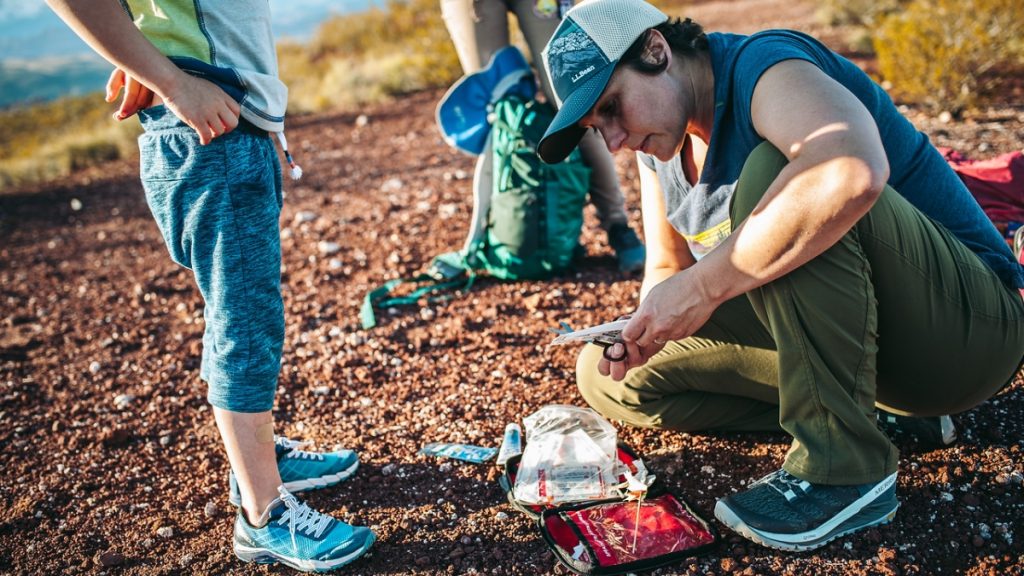Hiking energizes and centers you, but trekking along nature trails and across countrysides comes with its fair share of risk. Harsh weather or a single misstep could end in a sprained ankle or sunburn. Learning how to control bleeding, close a wound, and treat burns are a few first aid tips that could help you know what to do when disaster strikes in the great outdoors. Use these six tips to make your hikes safer and more enjoyable.
1. Bring the Right Items and Equipment
No matter what mishaps you encounter off or on the beaten path, you need a well-stocked first aid kit to treat various injuries and respond to emergencies. For a long-distance hike, pack lip balm, gauze, tweezers, blunt-end scissors, and plenty of bandages. Bring sterile dressings, mole pads, second skin, and over-the-counter pain medication for shorter hikes.
Headlamps may not be the first thing you think of when you are packing a first aid kit, but mishaps can happen at night or in poor lighting conditions. So pack a reliable light that you can use while administering first aid. Pack headlamps to provide a viable light source while administering first aid. Quality lights like Fenix flashlights also come with multiple modes that enable you to set different levels of brightness. Carrying one of these will ensure that not only can you navigate planned routes, but can also manage any unexpected injury on the trail.
2. Close Wounds Quickly
You must clean and close gaping wounds as quickly as possible to avoid infection. Rinse the area around the cut with clean water before applying an antibiotic ointment to the injury and wrapping it in a bandage, which puts pressure on the wound and staunches bleeding. Medical dressing and tape and skin closure strips help seal the wound.
Deep wounds could send a person into shock. If that happens, keeping the person warm with a hot beverage may help.
3. Treat Ankle and Knee Injuries Yourself
Sustaining a knee or ankle injury during a hike could require an emergency medical rescue, which may involve a lengthy wait. Rather than take unnecessary risks, learn how to treat such injuries yourself. First, test the injury to see if the affected knee or ankle can still bear weight. If so, bandage the wound with an ace bandage or athletic tape before continuing your hike at a less-intense pace with plenty of breaks. If the ankle or knee cannot bear weight, wrap it in a splint or cover it with protective padding.
4. Treat Burns With Clean Water
Building a fire during an overnight hike is a great way to stay warm, create wonderful memories, and prepare meals. Sitting too close to the flames, however, or not paying attention could cause burn injuries. Quickly cool the injury to stop the burning with clean, cold water. Then, wash the burn, apply an antibiotic ointment, and dress the wound to help keep it free of infection.
5. Control Bleeding With Proper Wrapping
You may already know how easy it is to sustain a cut, one of the most common hiking injuries. If a cut bleeds, treat the injury by applying pressure and elevating the wound above the heart. Next, apply gauze to the cut before bandaging it with something like a clean towel, ace wrap, or bandana. Avoid wrapping the injury too tightly by checking that at least two of your fingers fit under the wrap. If they don’t, loosen the bandage.
6. Get Rid of Ticks Carefully
While undoubtedly annoying, tick bites also carry Lyme disease and may trigger an infection. Use tick keys or tweezers to grasp the tick near its mouth and gently pull it straight up to dislodge it, taking care that you do not twist the arachnid during extraction. Use an alcohol pad, antibiotic ointment, or iodine swab to clean the bite site.
Before setting out on your next hike, bring these tips and a well-stocked first aid kit with you. While you cannot account for every outdoor mishap, you can plan for it.

